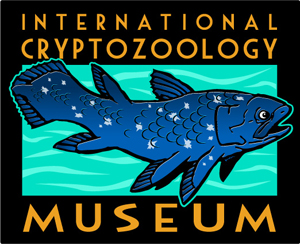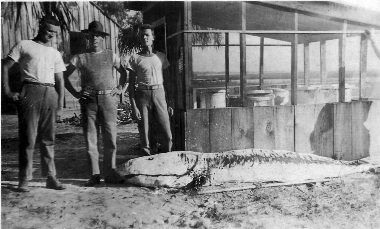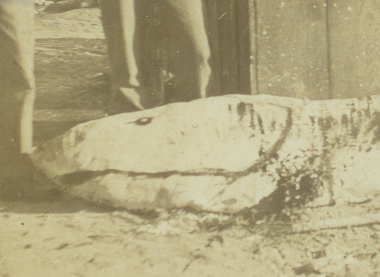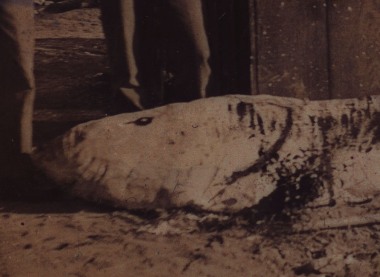Mystery Fish Photo
Posted by: Loren Coleman on April 13th, 2009
What is it?
That is not a simple question.
When the following photograph was first shown at Cryptomundo four years ago, there were only a few hundred of you reading this.

A year ago, 30,000 readers per day, with 3000 registered users examined it. Now, in April 2009, I want to celebrate our passing 11,000 registered users of Cryptomundo with this old favorite. Some days, 1.9 million people read these pages. Cryptozoology is alive and well as an active quest.
There is no reason not to revisit this lovable topic of Cryptomundians. If you haven’t seen this mysterious postcard before, you might be interested in leaving your opinion. If you’ve had your say before, you might want to take a new look.
Get that enhancement software uploaded, pick up your magnifying glasses for another look at the “Mystery Fish Photo.” If you are new here, take a moment with this one.
As oldtimers here may recall, despite speculations, theories, thoughts, rumors, ideas, hypotheses, and claims, this longest standing mystery at Cryptomundo has never been fully solved.
The postcard photo was originally sent to me by Phyllis Mancz of Ohio.
The Mystery Fish postcard, first noted here on November 29, 2005, has never been identified, as to exact location or species. New people sometimes have new ideas. Lots of new readers may not be familiar with this Cryptomundo mystery. So here goes….(if you are a seasoned Cryptomundian, please have patience; a new look might really help).
(Click on image to see full size version, enhanced by shockbeton)
Due to research (see below) on the type of postcard it is, there was a determination that this specific item would have been produced between 1904-18.
The location seems to be in the Pacific; perhaps it was taken in the Philippines. Or maybe even Florida? Or the Caribbean?
One reader said this might be during WWI, in the south of France, because of the uniforms, but what of those palm trees? Where are these trees found? Can you identify the kind of trees?
Due to several requests for a closeup of the head of the mystery cryptid on the postcard, here’s a computer enhancement.
What do you see here?
(Click image for full-size version)
(Click image for full-size version, provided by Todd DiLaMuca)
(Click image for full-size version, provided by Todd DiLaMuca)
Over 500 comments, most of them extremely thoughtful and detailed, can be found at the above noted entries, and yours are welcome anew, here, below. To date nearly 5,000,000 views of the Cryptomundo “Mystery Fish” photo have occurred.
(Click image for full-size version, provided by Todd DiLaMuca)
+++Date of the Postcard++++
The earlier discussions noted the date was between 1904-1918 for this postcard. For example, here, you can view the entire back of the postcard. Various pieces of research exactly determined that the diagnostic direction of the triangles give forth with a specific range of when these postcards were produced. While the men and the fish could have been photographed before 1904, it seems they could not have been photographed and appeared on this card after 1918.
The window of time for the producing of the card stock is, therefore, most probably, between 1890 and 1918.
The postcard has become such an enigmatic icon that it was incorporated by artists into the design on the front of my new edition of Mysterious America.

“We surpassed 11,000 yesterday. Now if only each one would donate $10….even $1!” ~ a remark by Cryptomundo founder Craig Woolheater to me, on April 9, 2009.

Save The Museum: An easy-to-use tool is available merely by clicking the “Donate” button below (remember, the upper righthand “Cryptomundo” button is for the admin of the blog and that money does not reach the museum or me). Thanks everyone!
You may directly send a check or money order if in the USA, or, if outside the USA, an international postal money order written to
International Cryptozoology Museum
c/o Loren Coleman
PO Box 360
Portland, ME 04112
Thank you.
Once again, the museum is not a 501(c)3.
About Loren Coleman
Loren Coleman is one of the world’s leading cryptozoologists, some say “the” leading living cryptozoologist. Certainly, he is acknowledged as the current living American researcher and writer who has most popularized cryptozoology in the late 20th and early 21st centuries.
Starting his fieldwork and investigations in 1960, after traveling and trekking extensively in pursuit of cryptozoological mysteries, Coleman began writing to share his experiences in 1969. An honorary member of Ivan T. Sanderson’s Society for the Investigation of the Unexplained in the 1970s, Coleman has been bestowed with similar honorary memberships of the North Idaho College Cryptozoology Club in 1983, and in subsequent years, that of the British Columbia Scientific Cryptozoology Club, CryptoSafari International, and other international organizations. He was also a Life Member and Benefactor of the International Society of Cryptozoology (now-defunct).
Loren Coleman’s daily blog, as a member of the Cryptomundo Team, served as an ongoing avenue of communication for the ever-growing body of cryptozoo news from 2005 through 2013. He returned as an infrequent contributor beginning Halloween week of 2015.
Coleman is the founder in 2003, and current director of the International Cryptozoology Museum in Portland, Maine.














Actually Loren, the men in this photograph could have been photographed after 1918 and printed on that card stock. I had brought that to the attention of Cryptomundo readers. So we can not exclude the possibility of this photo being taken after 1918.
In fact, I have seen this exact same card stock, in unopened packages, still available on Ebay and the internet, as recently as 4 or 5 months ago. This card stock was widely available during it’s hayday. And professional photographers, mom and pop stores, as well as commercial stores used this card stock.
While doing some spring cleaning last week, I found a pack of Kodak 8×10 black and white photo sheets from the 1970’s. That pack of photo paper is almost 40 years old. I printed a test strip to see if the paper was still viable. It was and the results of the test strip were as if I was printing it in the 70’s.
So with the availability of that exact card stock, still available in unopened condition, combined with the fact that photo papers remain viable for many years, we can not discount that this photo was not printed many years after 1918. Just because the photo paper is no longer produced, does not discount the fact that we can print a photo on that exact same paper today.
With that being said, Cryptomundo readers should expand the parameters of this photo when giving analysis. Keep an open mind!
Hard to say from the pic, but the palms look like Sabal palmetto palms (locally known as cabbage palms) to me, which would place it anywhere in Florida, East Coast up to NC or the northern Caribbean. The mystery fish looks kind of like a tiger shark (which would jive with the palms distribution) with the pectoral and dorsal fins cut off and the mouth slit into a “smile” of sorts.
Steve
1912. San Juan Del Sur in Nicaragua. Bony Fish.
I still vote that this is actually a decayed (or decaying) whale shark. It looks like the general appearence and the size would indicate a near newborn. With the low survival rate of almost all newborn shark species, this could be the explanation.
Going out on a limb, this may actually be the first documented discovery of the megamouth shark. It would be more fitting to the size of a juvinile.
Alternatively, this may look the MOST like a Greenland shark, but given the palm trees I would say the photo was taken far from the natural range of the Greenland species. Perhaps an undiscovered tropical cousin??? That may be the case, but a slow moving opportunistic feeder would not survive as easily in the middle lattitudes as it would up in the arctic.
One more thing, upon closer observation it would also appear that it has been “cleaned” as you can see the long slit across the belly. The tail seems to have been cut off as well. That would also possibly work with the fins being cut off as that is something that might be done at the same time as the cleaning. Possibly the “smile” was cut in to remove the jaws.
That in combination with the blunt nose leads me to make the conclusion it is a altered tiger shark either in South Florida or maybe Cuba.
Steve
Unfortunately, ichthyology is not my forte, however three things strike me as odd right away
1) The creatures head appears to large for the body at least at this angle, which would support the previously suggested theory that the “fish” is on it’s side and had the top of its head cut to mimic a mouth, however, the beginning of the mouth is surprisingly natural looking, one can even see the outline of the jaw curving to the other side, while further back the “mouth” looks far less uniform. 2) The tail of the “fish” lies flat, again suggesting that it is on it’s side.
3)The area just after the head has a suspicious blur to it, perhaps indicating some doctoring…
I hope these observations weren’t too nonsensical…
Megamouth! Look at current pictures of Megamouths. Also, not by coincendence I suspect, a large sample of the known megamouth findings have come from the Philippines area (as well as the most recent one).
As a seamstress and costume maker (among other things) I think you can get a little closer in your date. This photo could NOT be prior to 1913-1914. Here’s why….
First, the t-shirts. Nobody knows exactly when the first T-shirt was produced, but there is documentation dating back to as early as 1913 that the US Navy adopted the crew-necked, short-sleeved, white common undershirt, to be worn under overalls to conceal sailors’ chest hair.
Second the pants: The Hookless Fastener No. 2, (what we now refer to as a zipper) was first used in 1914 by the military for trousers for the Army and Navy. Prior to that, men’s trousers had 7 buttons.
So…a little closer…haven’t checked on the hat style, but I suspect that too could be dated.
I’m skeptical of the photograph, to be honest. Where are the gills? And the dude in the middle looks like he straining to keep a straight face.
I could buy into the megamouth theory, but it still has the fins cut off. But the jaw still just does not look right, even for a megamouth. My vote still lies with mutilated tiger shark.
The gentleman in the center is a Marine. He is wearing a hat called a campaign cover. In the center is the USMC Eagle, Globe and Anchor. This hat came into use around 1912. Of course Marines were stationed around the world so I’m afraid this might not help much.
Looks fishy. Haha.
Seriously, if it was some new, previously unknown species, I would think the men would have taken a few more detailed pictures and even tried to make some money off it, selling the news to a paper or something.
People tend to like money and fame, and the fact this picture is the only known documentation of this find and it was printed on a postcard that, as pointed out on comments above, seems to be older than the date the photo was taken, on top of the suspicious blur, all seem to point to hoax. Perhaps the maker of this postcard was indeed motivated by money, as it was the only way they could get someone to buy a postcard.
I dunno what this animal is, not being very familiar with water animals. I just had to post this because…. Does anyone else see the bigfoot er sasquatch shadow on the right side of the pic? On the wooden planks behind the tail? Especially when you enlarge the photo.
🙂 how Crypto!
I with steve about the location. The palms resemble those on the Southeast coast or Gulf area. There is also what looks like a live oak behind the large building. The location is also in what looks like a saltwater marsh area. See the marsh grass and creeks? That is not a beach. They are standing on sandy dirt and grass. The background also shows a flat landscape like a delta or tidewater area. The structures also seem American style. They are angular and wooden. That requires plentiful hardwood. Populated islands are typically stripped of their large hardwood resources early.
It’s a guy in a suit, I can see the zipper.
To me it seems to be a shark. It has been gutted and all of the fins and the tail have been cut off, but the head definitely looks shark like. As for the species I couldn’t say.
I believe that this is a tiger shark that has been skinned. The dark blotched pattern along the side corresponds to the location of the darkest and bloodiest meat on a fish. The tail and dorsal fins have been removed. There is a hole where the pectoral fins should be. The nose is characteristic of a tiger as well.
As far as location, have you considered that this could have been taken near Parris Island, SC. The marsh in the background looks very similar to the marshes I’ve seen around Charleston, SC. There are abundant palm trees, live oaks, and Marines too!
One last thing. The IGFA world record tiger shark was caught off of a pier in Myrtle Beach, SC. They would have been plentiful around the turn of the century.
To me the head seems to be shark like…
You know in his books Dr. Karl P.N. Shuker, British zoologist and cryptozoologist, has spoken of people who would take various parts of animals and construct “fantastic creatures” such as merfolk. It is possible that this fish is nothing more than a shark’s head sewed onto a fishes body with the hope of luring some unknowing folk into paying for a look, or even buying a postcard?
What you have there, is what is known locally as a “fake fish” made of wood and cloth. I can’t imagine that anyone looking at the large photographs of the head can’t see that the mouth is a line of black paint and the eye (with the ridiculous brow) has a painted on shine.
It looks like a wind sock, for crying out loud.
The third of the enhanced photos make it look like there are two sharks posed together… The “head” is one shark at a slightly frontal-ventral angle so its belly is actually the “nose” of the mystery fish, the upward curvature of the “smile” is the actual mouth of the shark and the “eye” looks like some sort of puncture wound.
Both animals have had their fins removed….
The sharp angle of the “nose” can be explained by the state of the carcass and how much has been removed from it, possibly through an unseen incision. The dark shadow in the “gill” area of the mystery fish would just be the cone of shadow resulting from putting one animal over the other, and the long “mouth” is just a cut made probably while the animal was hanging head down from a hook.
Also, it would strike me as obvious that the lads in the photo, being apparently in the military, would do this to amaze their friends and families back home.
I’ve spoken about this animal before, and despite what others are saying I still do no believe it is a shark. I have both skinned and seen many dead sharks and I do not think this creature is a shark. It may be a “white” fish of some sort, or another type of animal.
One new thought has occurred to me. The hat mentioned is also similiar to those worn by the Mexican army some time ago, and even if the hat is military issue, there is no reason to expect it to shown during a military campaign or station. Is it therefore possible that the creature is a grey whale foetus, pictured in a fish camp on the Sea of Cortez during the tuotova fishery from the 1920’s to 1950’s ? Turn the picture upside down to see the possibility of a cetacean’s jaw structure, and remove the pebble they have put there for an eye. Perhaps the men involved took the opportunity of finding something unusual on a beach to create a hoax of their own ? Boredom does the for you.
Decaying tiger shark with jaws and fins removed.
In my humble opinion, it is a washed up/decomposing “Frilled” Shark. One of the rare creatures was video taped a couple of years ago by Japanese marine park researchers.
Please see this Reuters news story on the rare specimen, filmed both alive and dead.
All the best!
Could be a frilled shark, but those usually are much smaller. They may get up to 6ft, but the proportions are not really correct compared to the picture above. If this is a frilled shark it is the momma of them all.
The eye and mouth have been drawn on, the object looks like a coconut log, decorated drift wood.
These guys (two USMC on right and a CB on the left) are bored as hell.
If it was a huge dead marlin or shark or whatever, what would motivate these fellows to park it next to their station buildings, in this case propped up against a shed. It would have to stink like all hell and not a likely arrangement for a tropical island.
Also, no flies.
In the tropics decomposition sets in almost immediately and the ‘rotting carcass’ (looks like painted driftwood to me) would turn into stinky mush in no time.
The other thing is– how/why would they transport this lump of carrion up to their station to pose for a picture without getting slimed.
If such a critter was tossed up on their beach or landed while fishing they would have
A. taken pictures with specimen on beach-
B. If it was captured live why wait till its rotten and then bring it home? To take a picture? I doubt they had something like a rotting seamonster in their encampment until it was rotten and then took a picture of it.
Think of the logistics and human behavior aspects of this scenario.
Also,
The camera’s make and model could very well have been already antiquated by the time the photo was taken, being in a remote location it may have had that camera since it was new.
The make and model and film/digital specs can often greatly ‘post-date’ the time/date that the photo was taken.
Camera gear wasnt always as ubiquitous as today.
While the camera dated from the pre-1918 period it may have been in service many years later, especially if it depression era gov surplus.
I Think it is a decorated length of drift wood on a US Navy/USMC station during the 1920’s. The photo likely had ‘inside joke’ significance to the fellows pictured.
I highly doubt anyone would carry a large smelly dead marine creature into their compound and park against a shed for a photo.
The fish photo. It looks like a partially butchered shark. The back of the postcard has “AZO” printed in the “place your stamp here” square. “AZO” usually stands for the Portuguese Azores where you will find exotic looking trees. The weather made it a popular fishing/vacation spot in the early 20th century -fishing in Portuguese waters you caught many exotic fish as it was near Africa. The guys do not look like they are military but wearing casual “rough gear”.
Not sure if that helps or hinders things!
I’ll be honest—I have no idea what that is.
If I HAVE to hazard a guess, I’d say skinned shark.
Whatever it is—still a fascinating picture.
Agree with SmoovRobG that it could be a skinned and gutted Frill Shark. The nodules near where the gill covers might’ve been look like the partly exposed gills which give the shark its name.
See pic.
I once raised salamanders from eggs, and in the stage before they got legs they looked VERY much like this. Except they were an inch long. I would hate to see the salamander this guy would turn into!
Just watched “River Monsters” last night on Animal Planet channel. Jeremy Wade went in search of the wels catfish in Spain’s Rio Ebro. Could this be one of the “monster” catfish that still exist?
Looks like a coelacanth. One was caught off the coast of Africa around the same time of this.
I think it’s real, some unknown shark perhaps, but to me, it is certainly a cryptid, and here’s why.
First of all, I see a tail. A fish tail to be sure, on the far right, but a tail nevertheless. It is augmented the same way as a reptile would have a tail, so anything like a whale fetus is out. Laying more or less flat, and hard to see, to be sure, but it has a tail.
Secondly, blood. What looks like a wound at the top right of the head, looks like a bullet hole. And the blood spatter going down the side of the head, looks what it would be like if a creature got shot. The other blood aspect is right where there would technically be a throat. Where the head meets the body, it looks very dark, bloody as it were. That’s from slitting it’s throat. Pump a round in it’s head and slit it’s throat, just like they do when they hang up sharks.
Thirdly, where the head meets the body, look closely and you’ll notice the coloration doesn’t match. That’s because it’s a gill cover. Look on any fish, dead or alive, and when the gill cover is slightly open, it gives the impression of a larger more squared off head. Look at the coelacanth logo from Cryptomundo itself, the gill cover is squared off similar to this.
Finally, the mouth. Although it looks drawn on or fake, the part that goes upwards at the back of the head could be part of the gill mechanism. Water goes inside the slit, flows over the gills, and exits. And remember, if we are trying to compare an unknown creature with an unknown body style to known creatures with known body styles, they may not even come close to matching. It may be something completely different, exactly what I believe is pictured here.
I have no expertise in anything But, I lived in the Florida Keys in the 60’s 70’s and 80’s. Similar scenes were common back then and forest ranger types wore similar hats as did regular guys who just had those hats. The trees look like hundreds I’ve seen before from the Keys up to South Carolina.
The creature though isn’t something I recognize at all. It doesn’t look anything like any shark I’ve ever seen and I’ve seen quite a few. I’ve seen them wash up dead and deteriorating, I’ve seen them skinned and cleaned with jaws removed. But I’ve never seen anything like that.
It’s been years but if I recall, to remove the jaws of any shark you have to cut away a lot more flesh and skin then you might think, which leaves a much larger gape.
I agree that it looks to have been shot and I also see a tail (small for the size but a tail none-the-less). What looks like a “smile” could be a blood trail from the mouth if the head was elevated and the whole thing turned. I can also see where the gill is.
To me the guy in the middle looks like his shirt should also be white but is very dirty. Maybe blood from cleaning the fish? It also looks like it’s on his upper pants.
I very rarely think these things (cryptid photos) are real but this one I do think is. Whether it’s an actual cryptid or not, I have no idea.
Anyone know if it’s ever been sent to National Geographic or the like to see if they can identify it?
I used to think it was possibly a shark, hard to identify. I am now leaning towards possible white sturgeon.
Tiger Shark, Parris Island, Beaufort, South Carolina